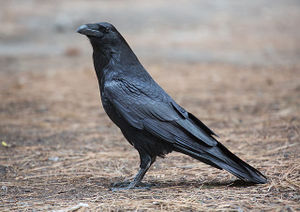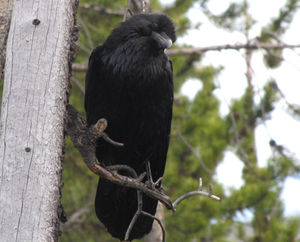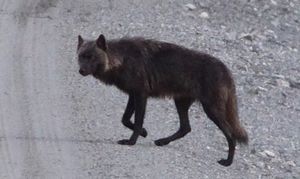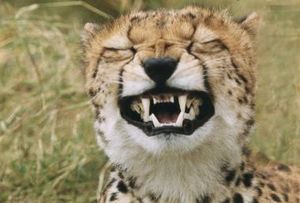|
|
| Line 1: |
Line 1: |
| − | Some animals are seen around fairly often -- or at least some other creature much like them is spotted now and then. | + | Some animals are seen around fairly often -- or at least some other creature much like them is spotted now and then. Others are rumoured to have been [[Former Animals of Albuquerque|seen in the past]], although the trustworthiness of those stories varies... |
| − | {| id="layoutTable" | + | {| id="layoutTable" width="1008px" |
| | |- | | |- |
| | !colspan=4 align=left|A Common Raven | | !colspan=4 align=left|A Common Raven |
| Line 12: |
Line 12: |
| | '''Breed:''' Corvus corax | | '''Breed:''' Corvus corax |
| | |- | | |- |
| − | |colspan=3 style="padding:0 10px;"| | + | |colspan=3 style="padding:0 10px; width: 680px !important;"| |
| | {{pad|3em}}''The Common Raven (Corvus corax), also known as the Northern Raven, is a large, all-black passerine bird in the crow family. Found across the northern hemisphere, it is the most widely distributed of all corvids. There are eight known subspecies with little variation in appearance although recent research has demonstrated significant genetic differences among populations from various regions. It is one of the two largest corvids, alongside the Thick-billed Raven, and is possibly the heaviest passerine bird; at maturity, the Common Raven is between 56 and 69 cm (22 to 27 inches) in length, with recorded weights ranging from 0.69 to 1.63 kg (1.5 to 3.6 pounds). Common Ravens typically live about 10 to 15 years in the wild, although lifespans of up to 40 years have been recorded.''<br /> | | {{pad|3em}}''The Common Raven (Corvus corax), also known as the Northern Raven, is a large, all-black passerine bird in the crow family. Found across the northern hemisphere, it is the most widely distributed of all corvids. There are eight known subspecies with little variation in appearance although recent research has demonstrated significant genetic differences among populations from various regions. It is one of the two largest corvids, alongside the Thick-billed Raven, and is possibly the heaviest passerine bird; at maturity, the Common Raven is between 56 and 69 cm (22 to 27 inches) in length, with recorded weights ranging from 0.69 to 1.63 kg (1.5 to 3.6 pounds). Common Ravens typically live about 10 to 15 years in the wild, although lifespans of up to 40 years have been recorded.''<br /> |
| | {{pad|3em}}''In other words, it's another damn bird.'' | | {{pad|3em}}''In other words, it's another damn bird.'' |
| | |- | | |- |
| | |colspan=3 valign=bottom align=center|<gallery perrow=5 widths="75px" heights="75px"> | | |colspan=3 valign=bottom align=center|<gallery perrow=5 widths="75px" heights="75px"> |
| − | Image:ACRaven1.jpg | + | <!--Image:ACRaven1.jpg--> |
| − | Image:ACRaven2.jpg
| + | |
| − | Image:ACRaven3.jpg
| + | |
| − | Image:ACRaven4.jpg
| + | |
| − | Image:ACRaven5.jpg
| + | |
| | </gallery> | | </gallery> |
| | |- | | |- |
| Line 48: |
Line 44: |
| | Image:ALRaven7.jpg | | Image:ALRaven7.jpg |
| | Image:ALRaven5.jpg | | Image:ALRaven5.jpg |
| − | </gallery>
| |
| − | |-
| |
| − | !colspan=4 align=left|Barred Owl
| |
| − | |-align=center
| |
| − | |rowspan=3|[[Image:BarredOwl.jpg|300px]]
| |
| − | |width=120px|
| |
| − | '''Sex:''' Unknown
| |
| − | |width=120px|
| |
| − | '''Age:''' Unknown
| |
| − | |width=120px|
| |
| − | '''Breed:''' Unknown
| |
| − | |-
| |
| − | |colspan=3 style="padding:0 10px;"|
| |
| − | {{pad|3em}}''Description.''
| |
| − | |-
| |
| − | |colspan=3 valign=bottom align=center|<gallery perrow=5 widths="75px" heights="75px">
| |
| − | Image:BarredOwl1.jpg
| |
| − | Image:BarredOwl2.jpg
| |
| − | Image:BarredOwl3.jpg
| |
| − | Image:BarredOwl4.jpg
| |
| − | Image:BarredOwl5.jpg
| |
| | </gallery> | | </gallery> |
| | |- | | |- |
| Line 85: |
Line 60: |
| | |- | | |- |
| | |colspan=3 valign=bottom align=center|<gallery perrow=5 widths="75px" heights="75px"> | | |colspan=3 valign=bottom align=center|<gallery perrow=5 widths="75px" heights="75px"> |
| − | Image:BWolf1.jpg
| + | <!--Image:BWolf1.jpg--> |
| − | Image:BWolf2.jpg
| + | |
| − | Image:BWolf3.jpg
| + | |
| − | Image:BWolf4.jpg
| + | |
| − | Image:BWolf5.jpg
| + | |
| − | </gallery> | + | |
| − | |-
| + | |
| − | !colspan=4 align=left|Bobcat | + | |
| − | |-align=center
| + | |
| − | |rowspan=3|[[Image:Bobcat.jpg|300px]]
| + | |
| − | |width=120px|
| + | |
| − | '''Sex:''' Unknown
| + | |
| − | |width=120px|
| + | |
| − | '''Age:''' Unknown
| + | |
| − | |width=120px|
| + | |
| − | '''Breed:''' Unknown
| + | |
| − | |-
| + | |
| − | |colspan=3 style="padding:0 10px;"|
| + | |
| − | {{pad|3em}}''Description.''
| + | |
| − | | + | |
| − | | + | |
| − | | + | |
| − | |-
| + | |
| − | |colspan=3 valign=bottom align=center|<gallery perrow=5 widths="75px" heights="75px">
| + | |
| − | Image:Bobcat1.jpg | + | |
| − | Image:Bobcat2.jpg
| + | |
| − | Image:Bobcat3.jpg
| + | |
| − | Image:Bobcat4.jpg
| + | |
| − | Image:Bobcat5.jpg
| + | |
| − | </gallery>
| + | |
| − | |-
| + | |
| − | !colspan=4 align=left|Cougar
| + | |
| − | |-align=center
| + | |
| − | |rowspan=3|[[Image:Cougar.jpg|300px]]
| + | |
| − | |width=120px|
| + | |
| − | '''Sex:''' Unknown
| + | |
| − | |width=120px|
| + | |
| − | '''Age:''' Adult
| + | |
| − | |width=120px|
| + | |
| − | '''Breed:''' Puma Concolor
| + | |
| − | |-
| + | |
| − | |colspan=3 style="padding:0 10px;"|
| + | |
| − | {{pad|3em}}''The deserts and national park have recently seen the arrival of a new predator, a mountain lion. Generally, the creature keeps its distance from humanity, but occasionally that calm, stoic cat can be seen wandering about outside of the city limits.''
| + | |
| − | | + | |
| − | | + | |
| − | | + | |
| − | |-
| + | |
| − | |colspan=3 valign=bottom align=center|<gallery perrow=5 widths="75px" heights="75px">
| + | |
| − | Image:Cougar1.jpg
| + | |
| − | Image:Cougar2.jpg
| + | |
| − | Image:Cougar3.jpg
| + | |
| − | Image:Cougar4.jpg
| + | |
| − | Image:Cougar5.jpg
| + | |
| − | </gallery>
| + | |
| − | |-
| + | |
| − | !colspan=4 align=left|Orb-Weaver
| + | |
| − | |-align=center
| + | |
| − | |rowspan=3|[[Image:Orb-Weaver.jpg|300px]]
| + | |
| − | |width=120px|
| + | |
| − | '''Sex:''' Female
| + | |
| − | |width=120px|
| + | |
| − | '''Age:''' Adult
| + | |
| − | |width=120px|
| + | |
| − | '''Breed:''' Nephila clavipes
| + | |
| − | |-
| + | |
| − | |colspan=3 style="padding:0 10px;"|
| + | |
| − | {{pad|3em}}''Spiders. They're everywhere - there are some forty thousand species of spiders on the planet, inhabiting every continent save Antarctica; they've established themselves in deserts, forests, swamps, grasslands, and absolutely everwhere else save possibly underwater. Any given acre of land is virtually guaranteed to have thousands if not hundreds of thousands of spiders. You might only see one or two, or even none at all, but rest assured: the one constant in life is that you are surrounded by spiders. ''<br />
| + | |
| − | | + | |
| − | {{pad|3em}}''This particular specimen belongs to the species Nephila Clavipes, a kind of golden orb-web spider. Judging by its large size, it is most assuredly female; the body itself, mainly orange-ish with a smattering of white dots, is a little over two inches in length. When you factor in leg span, the entire thing is roughly the length and width of a small beer can. The eight slender legs start out yellow at the base, but appear to have several black (actually very, very dark blue) stripes circling them as they approach the sharp tips.''
| + | |
| − | | + | |
| − | |-
| + | |
| − | |colspan=3 valign=bottom align=center|<gallery perrow=5 widths="75px" heights="75px">
| + | |
| − | Image:Orb-Weaver1.jpg
| + | |
| − | Image:Orb-Weaver2.jpg
| + | |
| − | Image:Orb-Weaver3.jpg
| + | |
| − | Image:Orb-Weaver4.jpg
| + | |
| − | Image:Orb-Weaver5.jpg
| + | |
| | </gallery> | | </gallery> |
| | |- | | |- |
| Line 174: |
Line 73: |
| | '''Breed:''' Isabelline Cheetah | | '''Breed:''' Isabelline Cheetah |
| | |- | | |- |
| − | |colspan=3| | + | |colspan=3 style="padding:0 10px;"| |
| | {{pad|3em}}''This large male cheetah stands a little over three feet tall at the shoulder and weighs just shy of 150 pounds. It's much lighter colored than the typical cheetah, with short and coarse, cream colored fur that's tan spotted, and a white belly. Its chest is deep, for an oversized heart muscle and lungs made for gulping air, its waist narrow to aid in folding its body while running at incredible speeds. The cat's muzzle is very short but filled with sharp teeth meant to tear meat. White claws are only semi retractable, remaining visible at all times and providing superior grip while running, and its long, thick, spotted tail is tipped with tan rings. A long haired, cream colored and tan spotted crest runs between its shoulders, tapering to an end at its mid-back, protective as well as able to display levels of aggression.''<br /> | | {{pad|3em}}''This large male cheetah stands a little over three feet tall at the shoulder and weighs just shy of 150 pounds. It's much lighter colored than the typical cheetah, with short and coarse, cream colored fur that's tan spotted, and a white belly. Its chest is deep, for an oversized heart muscle and lungs made for gulping air, its waist narrow to aid in folding its body while running at incredible speeds. The cat's muzzle is very short but filled with sharp teeth meant to tear meat. White claws are only semi retractable, remaining visible at all times and providing superior grip while running, and its long, thick, spotted tail is tipped with tan rings. A long haired, cream colored and tan spotted crest runs between its shoulders, tapering to an end at its mid-back, protective as well as able to display levels of aggression.''<br /> |
| | | | |
| Line 186: |
Line 85: |
| | Image:PaleCheetah4.jpg|I can has kiss? | | Image:PaleCheetah4.jpg|I can has kiss? |
| | Image:PaleCheetah5.jpg|Cheetah are notorious car thieves. | | Image:PaleCheetah5.jpg|Cheetah are notorious car thieves. |
| − | </gallery>
| |
| − | |-
| |
| − | !colspan=4 align=left|Royal Bengal Tiger
| |
| − | |-align=center
| |
| − | |rowspan=3|[[Image:RBTiger.jpg|300px]]
| |
| − | |
| |
| − | '''Sex:''' Male
| |
| − | |
| |
| − | '''Age:''' Adult
| |
| − | |
| |
| − | '''Breed:''' Panthera tigris tigris
| |
| − | |-
| |
| − | |colspan=3 style="padding:0 10px;"|
| |
| − | {{pad|3em}}''This is a healthy male tiger. The rusty orange and black-striped fur is as iconic as one might imagine, though this particular tiger is somewhat more massive than those usually seen in zoos or endangered species photo-shoots. His legs and shoulders are both powerfully built, and obviously capable of pulling down substantially heavier prey than himself. The creature looks to weigh around at least an impressive 320 kg (~700lbs), and measures something like 280cm of total body length. As for those stripes, there are at least 100 from tail-tip to face, the pattern unique as any fingerprint. Plentiful whiskers sprout from a muzzle slightly more depressed than the tiger's smaller feline brethren, and his eyes are a bright yellow-gold surrounding a round pupil, clearly perceptive.''
| |
| − | |-
| |
| − | |colspan=3 valign=bottom align=center|<gallery perrow=5 widths="75px" heights="75px">
| |
| − | Image:RBTiger1.jpg|Happy!
| |
| − | Image:RBTiger2.jpg|NOT HAPPY >:(
| |
| − | Image:RBTiger3.jpg|Whatever, water's totally awesome.
| |
| − | Image:RBTiger4.jpg|WHO PUSHED ME!? >:E
| |
| − | Image:RBTiger5.jpg|What? It's comfy!
| |
| | </gallery> | | </gallery> |
| | |- | | |- |
| Line 225: |
Line 103: |
| | |colspan=3 valign=bottom align=center|<gallery perrow=5 widths="75px" heights="75px"> | | |colspan=3 valign=bottom align=center|<gallery perrow=5 widths="75px" heights="75px"> |
| | Image:TimberWolf1.jpg | | Image:TimberWolf1.jpg |
| − | Image:TimberWolf2.jpg
| |
| − | Image:TimberWolf3.jpg
| |
| − | Image:TimberWolf4.jpg
| |
| − | Image:TimberWolf5.jpg
| |
| − | </gallery>
| |
| − | |}
| |
| − |
| |
| − |
| |
| − |
| |
| − |
| |
| − |
| |
| − | It's been a while since these others have been spotted in the area...
| |
| − | {| id="layoutTable"
| |
| − | |-
| |
| − | !colspan=4 align=left|A Serval Kitten
| |
| − | |-align=center
| |
| − | |rowspan=3|[[Image:boots.jpg|300px]]
| |
| − | |
| |
| − | '''Sex:''' Male
| |
| − | |
| |
| − | '''Age:''' Kitten
| |
| − | |
| |
| − | '''Breed:''' Leptailurus serval
| |
| − | |-
| |
| − | |colspan=3 style="padding:0 10px;"|
| |
| − | {{pad|3em}}''Boots is roughly half the size of a normal house cat. His long slim body is golden furred and covered with black stripes and rosettes. His tail is fluffy and round like a bristle brush made of silk, long and thick. His legs are incredibly long, with big paws that this kit hasn't quite grown into. His face is painted with a mask ready for mischief: triangle shaped, with huge slanted eyes of gold and orange. His ears are canted forward for play and, like giant triangular dishes, are bigger then his head as if, like his paws, he hasn't quite grown into his ears either. His face shows that despite his size he is still very young, for it is a kitten's face, all adorable and trouble at once.''<br />
| |
| − | {{pad|3em}}''Leptailurus serval is a medium-sized African wild cat. Modern molecular DNA analysis indicates that servals maintain their own unique lineage descending from the same Felid ancestor as the lion, and though the serval shares common traits with the cheetah, it is the cheetah which is thought to have descended from ancient servals. Similar DNA studies have shown that the African golden cat and the caracal are closely related to the serval.''
| |
| − | |-
| |
| − | |colspan=3 valign=bottom align=center|<gallery perrow=5 widths="75px" heights="75px">
| |
| − | Image:boots1.jpg|O hai! PLAY!
| |
| − | Image:boots2.jpg|I can haz this ball?
| |
| − | Image:boots3.jpg|O hai, waz this your bed?
| |
| − | Image:boots4.jpg
| |
| − | Image:boots5.jpg
| |
| − | </gallery>
| |
| − | |-
| |
| − | !colspan=4 align=left|Grizzly Bear
| |
| − | |-align=center
| |
| − | |rowspan=3|[[Image:Man-bear-hi-five.jpg|300px]]
| |
| − | |
| |
| − | '''Sex:''' Female
| |
| − | |
| |
| − | '''Age:''' Adult
| |
| − | |
| |
| − | '''Breed:''' Ursus arctos horriblis
| |
| − | |-
| |
| − | |colspan=3 style="padding:0 10px;"|
| |
| − | {{pad|3em}}''This is an unusual sight for the area of New Mexico. It's a fully grown grizzly bear that seems to stalk around the desert. It's around 4 feet at the shoulder and can stand up to 8 feet when it pulls up to its full height. Its bristled fur is all shades of brown and it currently shows a pretty good layer of fat already. Its eyes are black, gleaming with a strange intelligence as it looks about. Its claws are always showing on its large paws as it struts along. ''
| |
| − | |-
| |
| − | |colspan=3 valign=bottom align=center|<gallery perrow=5 widths="75px" heights="75px">
| |
| − | Image:Gbear1.jpg|ANGRY!
| |
| − | Image:Gbear2.jpg|Good beats!
| |
| − | Image:Gbear3.jpg|LUNCH TIME!
| |
| − | Image:Gbear4.jpg|
| |
| − | Image:Gbear5.jpg|
| |
| − | </gallery>
| |
| − |
| |
| − | |-
| |
| − | !colspan=4 align=left|Mexican Wolf
| |
| − | |-align=center
| |
| − | |rowspan=3|[[Image:MexWolf.jpg|300px]]
| |
| − | |width=120px|
| |
| − | '''Sex:''' Female
| |
| − | |width=120px|
| |
| − | '''Age:''' ???
| |
| − | |width=120px|
| |
| − | '''Breed:''' Canis lupus baileyi
| |
| − | |-
| |
| − | |colspan=3 style="padding:0 10px;"|
| |
| − | {{pad|3em}}''A small wolf around the size of a german shepherd, this beast is a typical example of Canis Lupus Baileyi, or the Mexican Wolf. Thick fur runs in striations of dark brown along the back, beige along the sides and face, and off-white along the chin and belly, while her tail is long and proudly plumed, tipped in black. She looks to be in good health, eyes bright and intelligent, nose wet and ears perked.''
| |
| − |
| |
| − |
| |
| − |
| |
| − |
| |
| − |
| |
| − |
| |
| − |
| |
| − |
| |
| − |
| |
| − |
| |
| − |
| |
| − |
| |
| − |
| |
| − | |-
| |
| − | |colspan=3 valign=bottom align=center|<gallery perrow=5 widths="75px" heights="75px">
| |
| − | Image:MexWolf1.jpg
| |
| − | Image:MexWolf2.jpg
| |
| − | Image:MexWolf3.jpg
| |
| − | Image:MexWolf4.jpg
| |
| − | Image:MexWolf5.jpg
| |
| − | </gallery>
| |
| − | |-
| |
| − | !colspan=4 align=left|Two Serval Kittens
| |
| − | |-align=center
| |
| − | |rowspan=3|[[Image:hekjek.jpg|300px]]
| |
| − | |
| |
| − | '''Sex:''' Male & Female
| |
| − | |
| |
| − | '''Age:''' Kittens
| |
| − | |
| |
| − | '''Breed:''' Leptailurus serval
| |
| − | |-
| |
| − | |colspan=3 style="padding:0 10px;"|
| |
| − | {{pad|3em}}''Hekyll and Jekyll, two young serval cats, are trouble and mischief personified. Roughly two times the size of normal house cats and able to stretch up to five feet, their long slim bodies are golden furred and covered with black stripes and rosettes, with long bottle-brush tails made of silken fur. Their legs are incredibly long with big paws. Their faces are patterned with masks ready for hijinx. Their heads are triangle shaped with huge slanted eyes of gold and orange and giant ears constantly canted forward for play, like huge triangular radar dishes bigger than their heads. These two stalk and play together, constantly in a tangle; one is never far from the other.''
| |
| − | |-
| |
| − | |colspan=3 valign=bottom align=center|<gallery perrow=5 widths="75px" heights="75px">
| |
| − | Image:hekel1.jpg|Hmm, what? I can haz your dinner!
| |
| − | Image:jekel1.jpg|I smell corndog!
| |
| − | Image:hekjek3.jpg
| |
| − | Image:hekjek4.jpg
| |
| − | Image:hekjek5.jpg
| |
| − | </gallery>
| |
| − | |-
| |
| − | !colspan=4 align=left|White Siberian Tiger
| |
| − | |-align=center
| |
| − | |rowspan=3|[[Image:WTiger.jpg|300px]]
| |
| − | |
| |
| − | '''Sex:''' Male
| |
| − | |
| |
| − | '''Age:''' Adult
| |
| − | |
| |
| − | '''Breed:''' Panthera tigris altaica
| |
| − | |-
| |
| − | |colspan=3 style="padding:0 10px;"|
| |
| − | {{pad|3em}}''The Siberian tiger (Panthera tigris altaica), also known as the Amur, Altaic, Korean, North Chinese or Ussuri tiger, is a subspecies of tiger which once ranged throughout Western Asia, Central Asia and eastern Russia, and as far east as Alaska during prehistoric times, though it is now completely confined to the Amur-Ussuri region of Primorsky Krai and Khabarovsk Krai in far eastern Siberia, where it is now protected.''
| |
| − |
| |
| − | {{pad|3em}}''The Siberian white tigers are simply white-colored Siberian tigers. A genetic anomaly, they are not a separate subspecies of tiger, and are not albinos. They have blue eyes, a pink nose, and creamy white fur with chocolate covered stripes. The Siberian white tiger is the largest and most rare of all members of the cat family.''
| |
| − |
| |
| − | {{pad|3em}}''Local legend has it that a number of years ago a white Siberian tiger cub escaped the local zoo and somehow adapted and survived somewhere in the national park. From time to time people swear to have seen the massive and mysterious 'ghost tiger'.''
| |
| − | |-
| |
| − | |colspan=3 valign=bottom align=center|<gallery perrow=5 widths="75px" heights="75px">
| |
| − | Image:WTiger1.jpg
| |
| − | Image:WTiger2.jpg
| |
| − | Image:WTiger6.jpg
| |
| − | Image:WTiger8.jpg
| |
| − | Image:WTiger3.jpg
| |
| − | Image:WTiger5.jpg|"I am not crazy! I'm just a little emotional right now, ok?
| |
| − | Image:WTiger7.jpg|Ya'll throwing all this stuff at me, man!
| |
| − | Image:WTiger4.jpg|Look, I mean, after this is over, can I like get a hug from you or somethin?"
| |
| − | Image:WTiger9.jpg
| |
| − | Image:WTiger10.jpg
| |
| | </gallery> | | </gallery> |
| | |} | | |} |
| | [[Category: Miscellaneous]] | | [[Category: Miscellaneous]] |
Some animals are seen around fairly often -- or at least some other creature much like them is spotted now and then. Others are rumoured to have been seen in the past, although the trustworthiness of those stories varies...
















